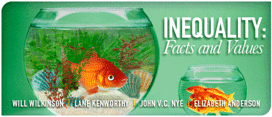John Nye suggests that innovation and productivity improvements tend, paradoxically, to reduce the actual degree of material inequality but to increase perceived material inequality.
Goods such as food, clothing, housing, cars, televisions, and many others come to be produced ever less expensively. As this happens, more people can afford to purchase them. This reduces material inequality. A rich American today may have four houses and seven cars. Yet the difference in material well-being between that person and someone who lives in a modest apartment and has one car is smaller than the difference between their counterparts of a century ago, when the rich person had two homes and one car and the poor person had no car and lived in a hovel with no heating or indoor plumbing.
As this process of material equalization proceeds, according to John, “the goods and services that remain objects of envy and inequality will be those that are most insensitive to improved efficiencies” — positional or status goods such as rare paintings, a spot in a top university, the most desirable housing locations in a city, the corner office, and so on. As a result, “the more we succeed in promoting wider access through growth, the more we will be focused on acquiring and differentiating ourselves on margins that are hard to change or difficult to equalize. Which will inevitably lead to more frustration as we mistake the material manifestation of those inequalities for the underlying differences themselves.”
I find this an interesting and plausible hypothesis about how things might play out at some point in the future. John, though, appears to view it as a useful account of what’s already occurred. Will Wilkinson concurs: “I think John’s story brilliantly accounts for the data,” he says. “Our society has become more economically egalitarian, in one profoundly important sense at least, but it sure doesn’t seem like it.”
I’m skeptical. Consider developments over the past century. The level of income inequality today probably is similar to what it was in 1910 — more inequality between the top 1% and everyone else, less inequality within the bottom 99%. But as I suggested earlier, inequality of material well-being is surely lower today. Do we nevertheless perceive that material inequality is greater today, as John hypothesizes? I have no idea, and I don’t know of any historical data on perceptions that would give us even a semi-educated guess.
What about the past three decades? Income inequality has risen sharply. Consumption inequality may have risen less sharply, but hardly anyone (including Will) contends that it has decreased. Has inequality of material well-being declined? Almost certainly not. If it doesn’t seem as though our society has become more economically egalitarian over the past generation, that’s probably because it hasn’t, rather than because Americans have shifted their focus to status goods.

